This post may contain affiliate links. Learn more.
This is a simple but very special pot of cooked red lentils, adapted from Chef Yotam Ottolenghi. Don’t miss this vegetarian, gluten-free meal with easy vegan option. It’s so good.
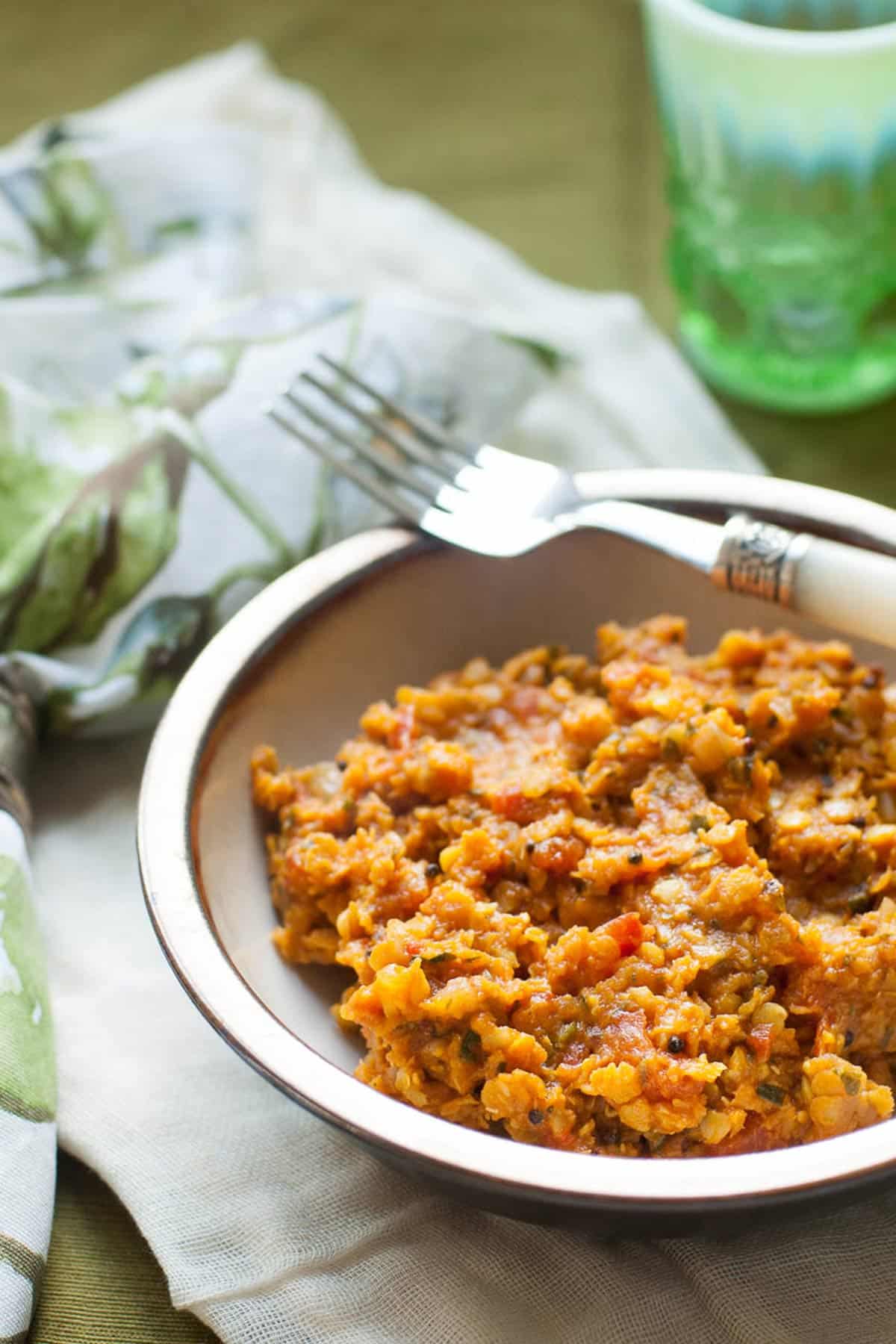
Why we love this recipe
If you’ve ever had anything to do with celebrated chef Yotam Ottolenghi, you’ll know right away that this recipe is special for a reason. The combination of flavors results in a dish that is:
- Deeply warm and comforting
- With layers of nuanced flavor
- While still being very straightforward to put together
- Ready in about 45 minutes
- Make-ahead friendly (it only gets better over time)
I originally published this adaptation in 2011. Over the years I’ve made my own additional tweaks to the recipe, but the flavor profile and the spirit of the dish remain unchanged.
What you’ll need
Here’s a glance at the ingredients you’ll need to make this recipe. A few of them may be new to you, so I’ll introduce them and let you know which ones are optional.
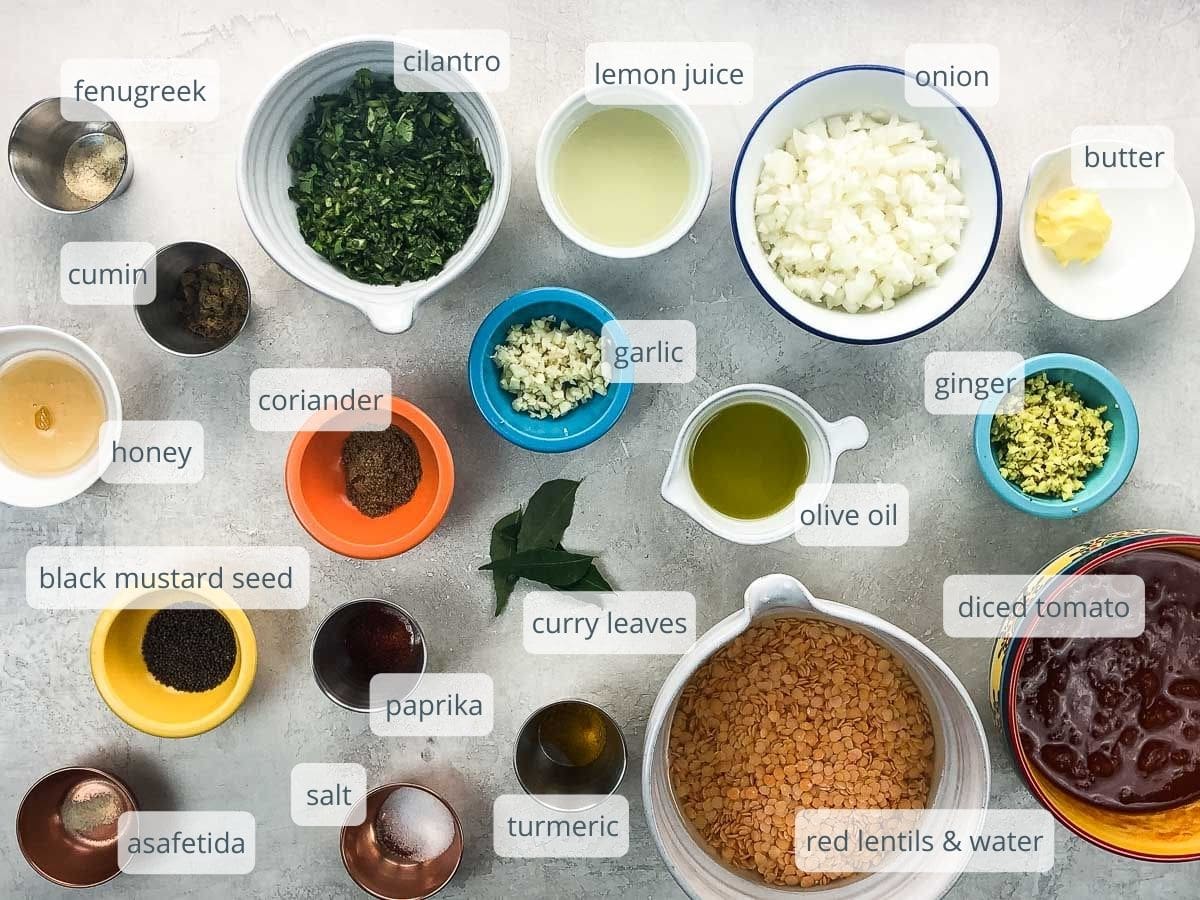
- Red lentils (sometimes called masoor) are a wonderful, versatile ingredient. They’re small and quick-cooking, full of protein and complex carbs, and great at soaking up flavors. There are several varieties commonly sold in the U.S., some smaller and redder, some a little bigger and more peach-colored. You can use them all interchangeably — just keep an eye on the cooking time and feel free to add a splash of water if you think it would be useful.
- Black mustard seed (sometimes called brown) is different from yellow mustard. It has a warmer, more complex flavor profile. Black mustard seed is a frequent ingredient in Indian and middle-eastern cooking and is well worth buying if you don’t already have it on hand. (You can type “black mustard seed” into the search bar on this site for some more great ways to use it.)
- Curry leaves come fresh or dried. You can use either version in this recipe, though fresh ones have a lot more flavor. If you’re lucky enough to have an Indian market nearby, buy them there, or at Whole Foods. Or get them online here or here (be sure to read reviews if buying on Amazon). If you can’t find them, you can leave them out.
- Fenugreek seeds and leaves are both used in cooking. This recipe calls for ground fenugreek (sometimes called fenugreek powder or ground methi). It has a beautifully aromatic, slightly sour character that adds a wonderful complexity to this dish and many Indian curries. Buy it online at Penzeys or The Spice Way if you can’t find it locally, though it’s easier to get in American supermarkets than you may think. It’s okay to leave it out if you can’t get it.
- Asafetida (also spelled asafoetida and sometimes called hing) is a dried, powdered resin that’s common in Indian vegetarian cooking. It’s part of the celery family and, in tiny quantities, magically enhances the flavor of curries. Buy it here if you can’t find it locally. It’s okay to leave it out if you can’t get it.
- At some point years ago for reasons I can’t remember, I started making this dish with olive oil, and it works just fine. But you’re welcome to use a more traditional choice like safflower oil or another neutral-tasting vegetable oil.
How to make it
Here’s what you’ll do to make a great pot of cooked red lentils. You can see the steps in action in the video that accompanies this post, and get all the details in the recipe card below.
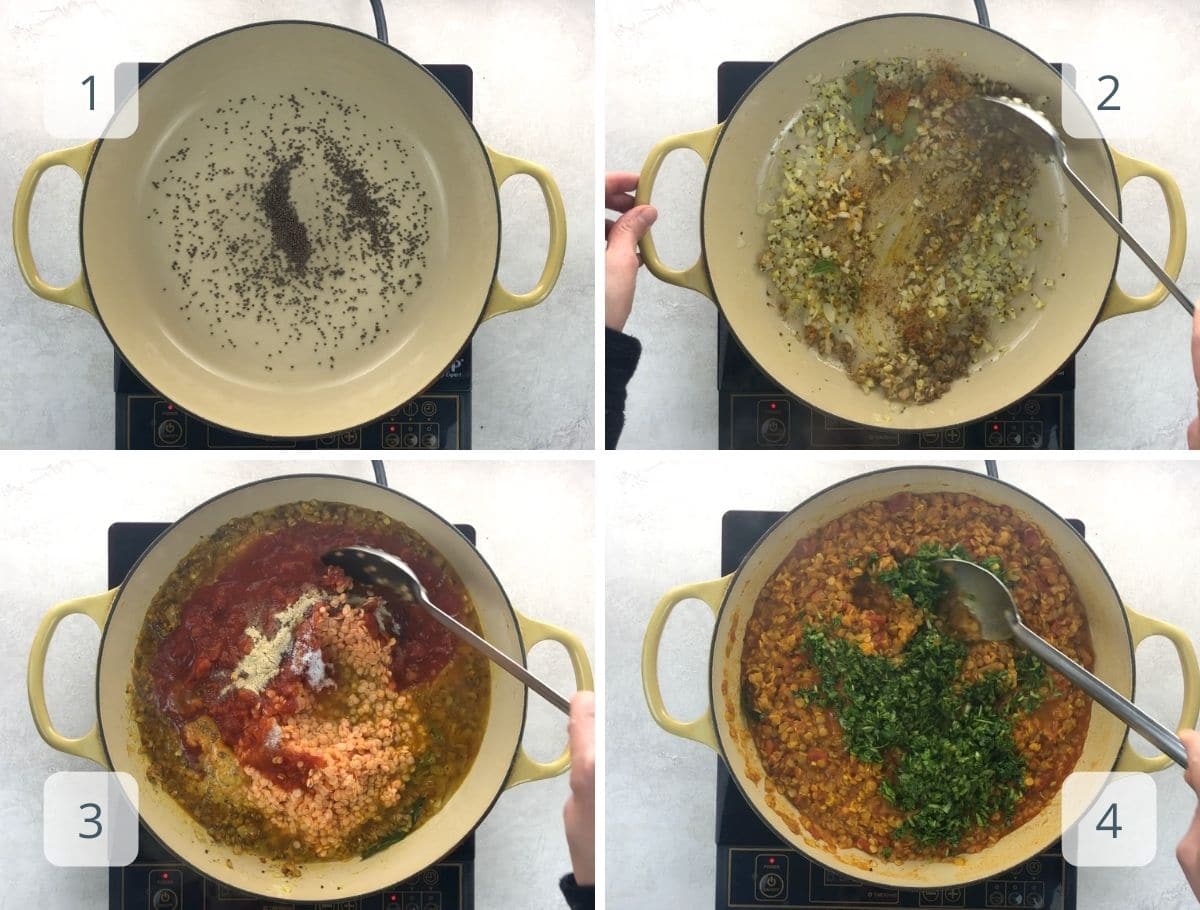
- The first step is to heat the mustard seeds in a dry pot until they pop. Then you’ll sauté the onion, garlic, and ginger along with the mustard seeds in the oil.
- Add the curry leaves and the ground spices that don’t mind high heat and cook, stirring constantly to prevent burning, for about two minutes.
- Then you’ll pour in the lentils with their soaking water, the tomatoes, and the other ground spices if you’re using them. Simmer, covered, until the lentils are cooked.
- Off the heat, stir in the butter, lemon or lime juice, and cilantro. That’s it!
Expert tips and FAQs
I’ve provided some online sources in the “What you’ll need” section above, but if those don’t work for you for some reason, don’t sweat it. Those flavors elevate this dish to a sublime level, but cooked red lentils are super-flexible, and this dish will be fantastic even without them.
You sure can. Just leave out the butter. You don’t need to make any other changes.
Yes. The flavors only improve over time, so make it anytime during the day and let it sit at cool room temperature, then reheat before serving.
Leftovers keep well tightly sealed in the fridge for up to a week, or in the freezer for up to a year.
More wonderful red lentil recipes
We are huge fans of red lentils around here. Here are a few more of our favorite ways to use them.
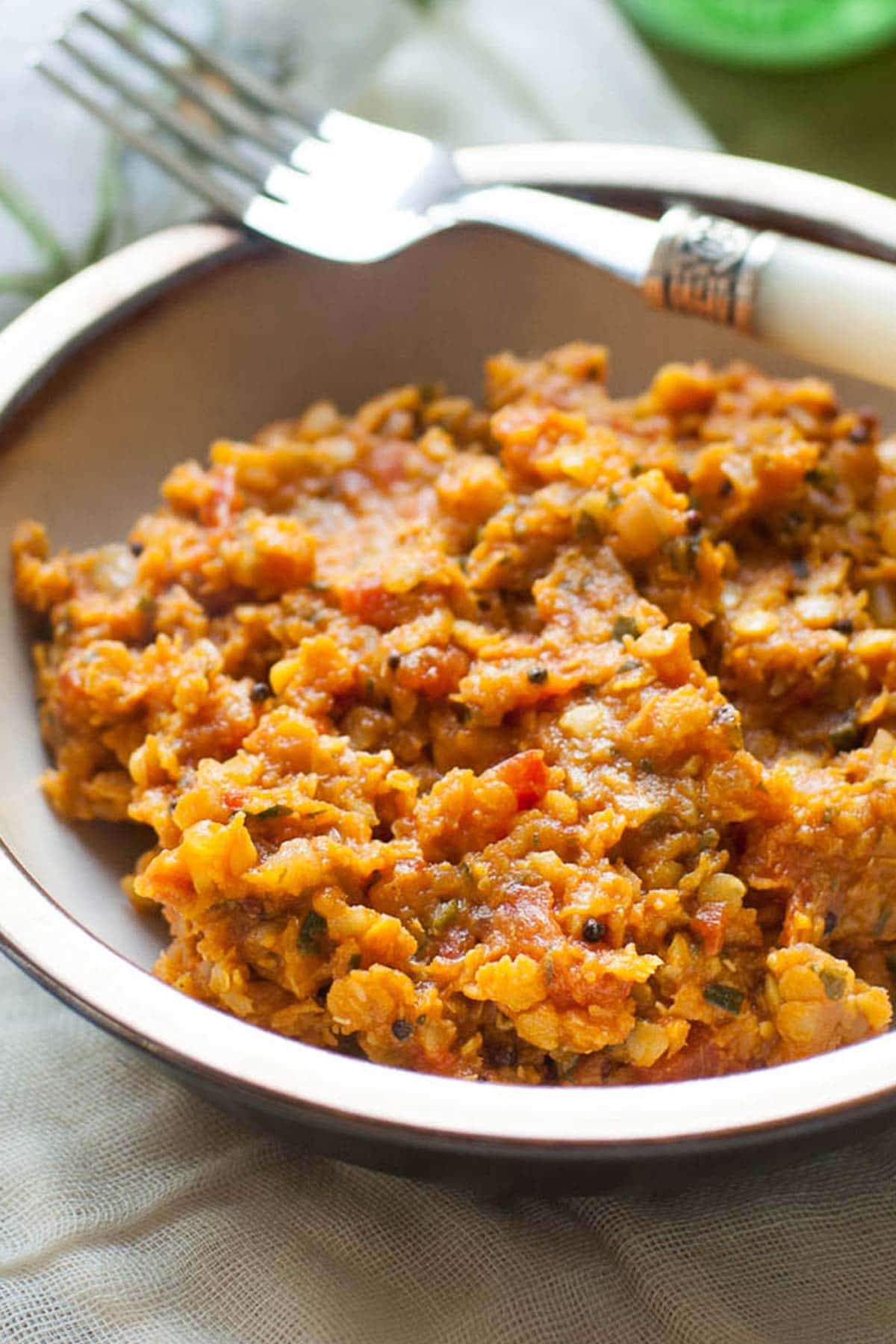
Hungry for more?
Subscribe to Umami Girl’s email updates, and follow along on Instagram.
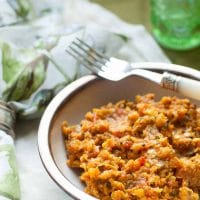
Cooked Red Lentils (Adapted from Ottolenghi)
Ingredients
- 2 cups (380 grams) dry red lentils
- 3 cups (710 ml) water
- 1 medium bunch, 4 ounces/(113 grams) cilantro
- 1 large yellow onion
- 6 garlic cloves
- 3- inch piece fresh ginger
- 1 tablespoon black mustard seeds
- ¼ cup (60 ml) olive oil
- 1 tablespoon ground coriander
- 2 teaspoons ground cumin
- 1 teaspoon ground turmeric
- ½ teaspoon ground sweet paprika
- 10 curry leaves
- 3 ½ cups (4 peeled chopped tomatoes, fresh or canned
- 1 tablespoon (honey
- ½ teaspoon ground fenugreek, optional
- ⅛ teaspoon asafetida, optional
- 1 teaspoon fine sea salt
- 2 tablespoons butter, optional
- 2 tablespoons freshly squeezed lemon or lime juice
Instructions
- Rinse the lentils well under running water, until the water runs clear. Then place them in a bowl with the 3 cups water and soak for 30 minutes. Do not drain.
- Meanwhile, mince the onion, garlic, and ginger.
- Finely chop the cilantro, including stems.
- Place the mustard seeds in a 5-quart Dutch oven or other pot with a heavy bottom, and cook over medium heat until they begin to pop.
- Add the onion, garlic, ginger, and olive oil. Reduce heat to low and cook, stirring frequently, for 3 minutes.
- Add the ground coriander, cumin, turmeric, paprika, and curry leaves, and continue cooking, stirring frequently, for 2 minutes.
- Add the lentils and their soaking water, the tomatoes, honey, fenugreek, asafetida, and salt, and stir to blend.
- Cover and simmer for about 20 minutes, until the lentils are fully cooked.
- Stir in the butter, lemon or lime juice, and cilantro.
Notes
- Adapted from Plenty by Yotam Ottolenghi. This is a beautiful book and very much worth owning.
- At some point years ago for reasons I can’t remember, I started making this dish with olive oil, and it works just fine. But you’re welcome to use a more traditional choice like safflower oil or another neutral-tasting vegetable oil.
- Curry leaves come fresh or dried. You can use either version in this recipe, though fresh ones have a lot more flavor. If you’re lucky enough to have an Indian market nearby, buy them there, or at Whole Foods. Or get them online here or here (be sure to read reviews if buying on Amazon). If you can’t find them, you can leave them out.
- Fenugreek seeds and leaves are both used in cooking. This recipe calls for ground fenugreek (sometimes called fenugreek powder or ground methi). It has a beautifully aromatic, slightly sour character that adds a wonderful complexity to this dish and many Indian curries. Buy it online at Penzeys or The Spice Way if you can’t find it locally, though it’s easier to get in American supermarkets than you may think. It’s okay to leave it out if you can’t get it.
- Asafetida (also spelled asafoetida and sometimes called hing) is a dried, powdered resin that’s common in Indian vegetarian cooking. It’s part of the celery family and, in tiny quantities, magically enhances the flavor o curries. Buy it here if you can’t find it locally. It’s okay to leave it out if you can’t get it.
- The flavors of this dish only improve as it sits, so feel free to make it in advance. Cook it anytime during the day and let it sit at cool room temperature, then reheat before serving.
- Leftovers keep well tightly sealed in the fridge for up to a week, or in the freezer for up to a year.
Nutrition
Nutrition information is automatically calculated, so should only be used as an approximation.
Hungry for more?
Subscribe to Umami Girl’s email updates, and follow along on Instagram.


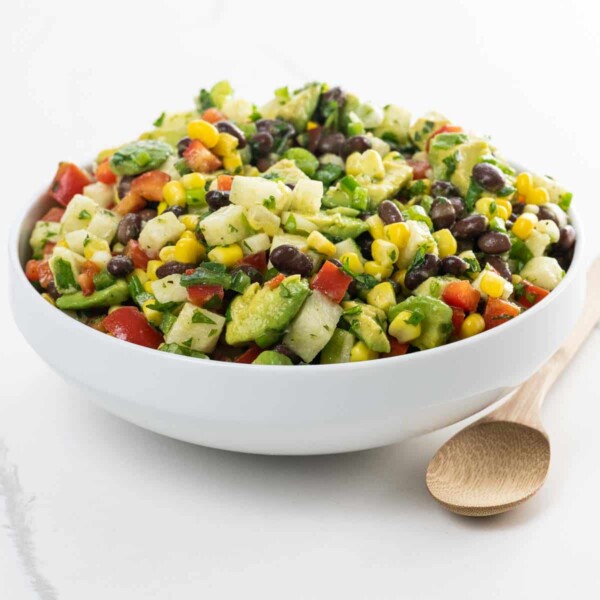
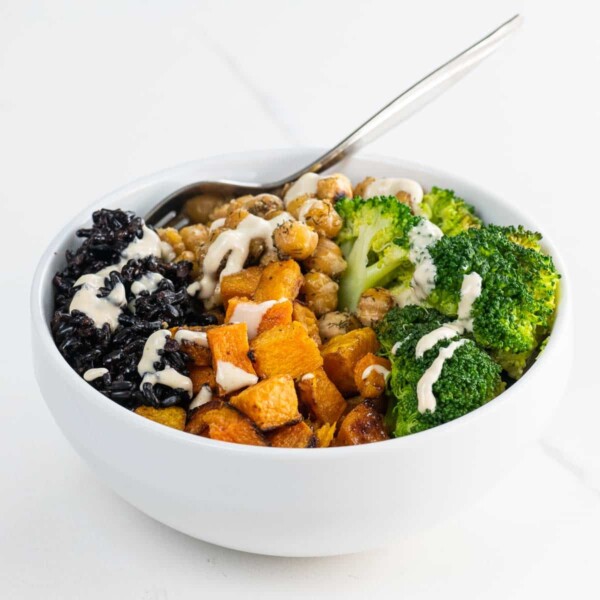
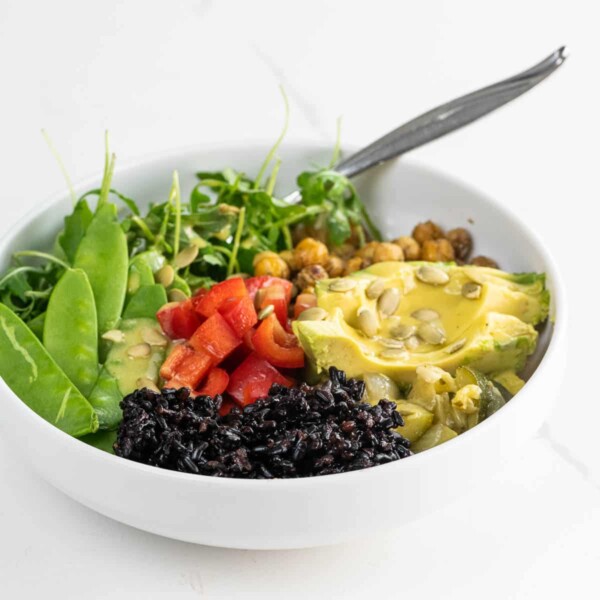
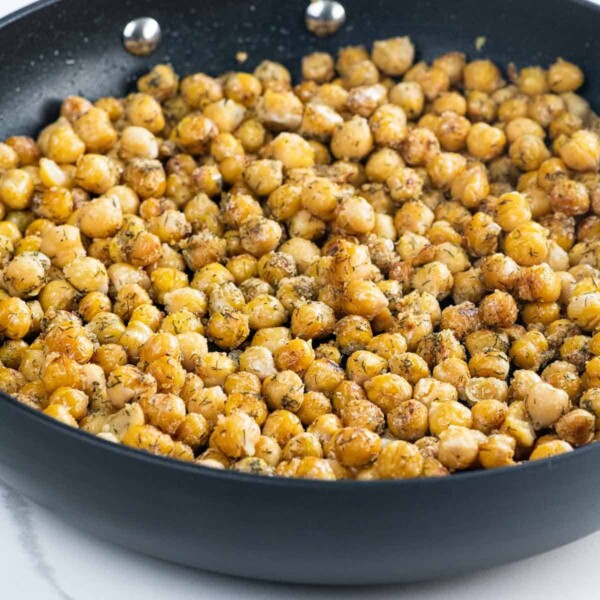







I’m looking forward to trying this recipe, but confused about the amount of water.
3 cups does not equal 473 ml.
Could you clarify, please?
Thanks
Ah, thank you for catching this! I’d added an additional cup of water to the recipe during a post update and forgot to update the metric. It’s 3 cups (710 ml).
Going to try making it today with the leaves…I LOVE the flavour of fenugreek leaves, so i like to use them whenever I get a chance. Yummy!
I love lentils and I love that Yotam is your Yoda! (I am married to a sci-fi geek 🙂 ). And I will most certainly be trying this recipe because it calls for about half of the spices in my pantry which I so need to use up. Oh and I believe the fenugreek in this recipe refers to the leaves because if they were the seeds you’d probably toast them with the mustard seeds first.
Ah! Thanks, Pat. That makes a lot of sense. Now I need to hunt down some fenugreek leaves and see what changes. Hope you’ll give the recipe a try!
Obsessed.
i want those lentils.
Thanks, Julia. It’s been a few weeks, so I want them again, too….